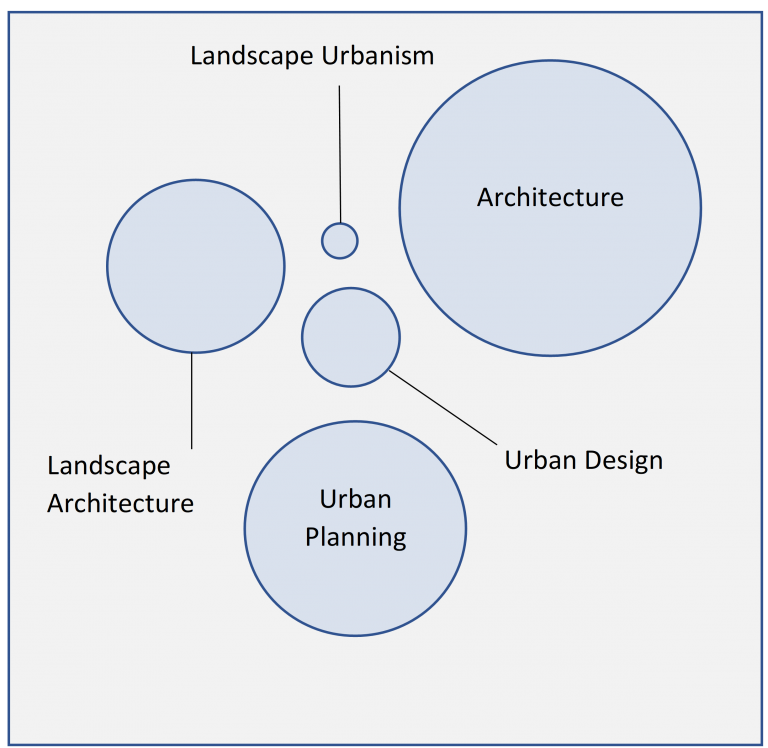What is Landscape Urbanism?
This blog introduces the theory of Landscape Urbanism, a theory of urban design which argues the city is constructed of interconnected and ecologically rich horizontal field conditions, rather than the arrangement of objects and buildings (Wikipedia 2022).
The blog will briefly explain the origins of the theory, describe where the discipline of landscape urbanism fits in relation to other urban design disciplines, and outline the potential benefits of adopting a landscape urbanism approach to urban design projects.
The formative period of Landscape Urbanism can be traced to the late 1980s, a time when Peter Connolly, Richard Weller, James Corner, Mohsen Mostafavi, and others were exploring the artificial boundaries of landscape architecture, urban design, and architecture, and searching for better ways to deal with complex urban problems.

This diagram, based on the work of Karl Kullman (2016) shows the interdisciplinary nature of urban design, and shows how urban design links the fields of Urban Planning, Landscape Architecture and Architecture.

This second diagram emphasises the proportion of professionals working in each discipline and also demonstrates Landscape Urbanism can be viewed as a separate discipline in its own right.
Protagonists of Landscape Urbanism see it as a “third way”; a visionary theory which unifies these disciplines. Charles Waldheim (2016) describes it thus: “Landscape Urbanism describes a disciplinary realignment currently underway in which landscape replaces architecture as the basic building block of contemporary urbanism……landscape has become the lens through which the contemporary city is represented and the medium through which it is constructed.”.
The theory of Landscape Urbanism is relatively recent, but is growing in popularity, mainly because it represents a more environmentally friendly and sustainable way of designing urban spaces than the more traditional approach where architects design buildings, and landscape architects design the public space between them.
Landscape Urbanism sees the urban development as an element in an ecosystem, or a layer in the landscape; urban development is therefore a component linked to both natural elements such as water and carbon cycles, geomorphological systems and food webs, and to man-made systems such as transport, housing and energy infrastructure.
Contemporary issues such as population growth, climate change, health, and social justice demand that urban spaces contribute positively to their surrounding environment whilst serving human functions, and the development of low carbon neighbourhoods, Sustainable Urban Drainage Systems and planning for green infrastructure are examples of the ways landscape urbanism has informed a more ecological and environmentally responsible approach to contemporary urban design.

Madrid’s Manzaranes River Project
References:
Connolly, Peter (2004). “Embracing Openness: Making Landscape Urbanism Landscape Architectural: Part 2”, in “The Mesh Book: Landscape/Infrastructure”, Edited by Julian Raxworthy and Jessica Blood, RMIT University Press, Melbourne, 200–219.
Corner, James (2006). “Terra Fluxus”. Landscape Urbanism Reader.
Kullmann, Karl (2016). Disciplinary convergence: Landscape architecture and the spatial design disciplines. Journal of Landscape Architecture. 11. 30-41.
Mostafavi, Mohsen; Najle Ciro (2003). Landscape urbanism: a manual for the machinic landscape. London: Architectural Association
Topos 71 -Landscape Urbanism. This issue includes contributions from Charles Waldheim, James Corner, Mohsen Mostafavi, Adriaan Geuze, Susannah Drake, Kongjian Yu, Frederick Steiner, and Dean Almy.
Waldheim, Charles (2016). Landscape as urbanism: a general theory. Princeton, New Jersey.
Wikipedia (2022) Landscape urbanism. Available at https://en.wikipedia.org/wiki/Landscape_urbanism (Accessed 22.3.22)


